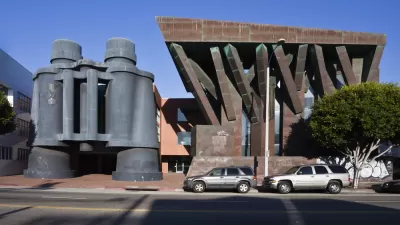As recently as a half-generation ago, California passed anti-immigrant laws, routinely elected Republican politicians, and wallowed in land use laws—like Prop. 13—enacted by conservatives. Manuel Pastor explains California's change of heart.

"For those of us who have forgotten — or never knew — Pastor makes this history abundantly clear in his new book State of Resistance. Starting in the 1950s, State of Resistance offers an accessible, lively account of California’s dramatic, and rapid, transformation from conservative, Republican, white-dominated promised land to liberal, Democratic, multiethnic redoubt. For planners, State of Resistance may prove indispensable for understanding the larger political trends in which they are working."
"Pastor adds a chilling layer to the common narrative that describes Prop. 13 as an older generation’s attempt to stick it to younger generations. Pastor reminds us that California’s new suburbs in the 1950s and 1960s "were highly segregated even as they were being rewarded with new schools, new roads, and even federal and state largess.” As the original suburbanites aged in place, they would have seen minority young adults moving in the their neighborhoods and minority children enrolling in local schools in 1978. Prop. 13 was thus the attempt (largely successful) of an older white generation to stick it to younger generations of color."
FULL STORY: Book Review: State of Resistance

Maui's Vacation Rental Debate Turns Ugly
Verbal attacks, misinformation campaigns and fistfights plague a high-stakes debate to convert thousands of vacation rentals into long-term housing.

Planetizen Federal Action Tracker
A weekly monitor of how Trump’s orders and actions are impacting planners and planning in America.

Chicago’s Ghost Rails
Just beneath the surface of the modern city lie the remnants of its expansive early 20th-century streetcar system.

Bend, Oregon Zoning Reforms Prioritize Small-Scale Housing
The city altered its zoning code to allow multi-family housing and eliminated parking mandates citywide.

Amtrak Cutting Jobs, Funding to High-Speed Rail
The agency plans to cut 10 percent of its workforce and has confirmed it will not fund new high-speed rail projects.

LA Denies Basic Services to Unhoused Residents
The city has repeatedly failed to respond to requests for trash pickup at encampment sites, and eliminated a program that provided mobile showers and toilets.
Urban Design for Planners 1: Software Tools
This six-course series explores essential urban design concepts using open source software and equips planners with the tools they need to participate fully in the urban design process.
Planning for Universal Design
Learn the tools for implementing Universal Design in planning regulations.
planning NEXT
Appalachian Highlands Housing Partners
Mpact (founded as Rail~Volution)
City of Camden Redevelopment Agency
City of Astoria
City of Portland
City of Laramie





























